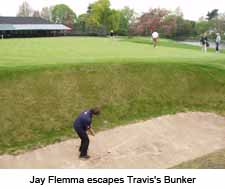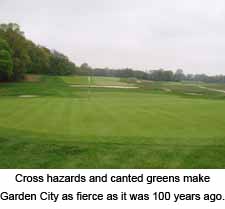Featured Golf News
The Grand Old Man, The Grand Old Club, The Grand Old Amateur

One of golf's most graceful traditions takes place this weekend. Far from any television towers, gallery stands and the latest, greatest waterfall ever built on a golf course, but far closer to the egalitarian spirit of the game as envisioned by her stewards, fabled Garden City Golf Club will host the 98th Walter J. Travis Invitational, a major amateur tournament of national and historic significance.
Originating as the "Spring Invitational" for the Metropolitan Golf Association, the tournament, now a mid-amateur event, has been conducted since 1902. Over the years, it has built its rich tradition upon three foundations: first, the legacy of Walter Travis, Garden City Golf Club's great amateur golfer and, later, a brilliant golf course architect; second, the brilliant golf course architecture of Garden City Golf Club which showcases the cunning routing of celebrated designer Devereux Emmet, as well as bunkering and green contouring by Travis himself; and finally, an unswerving devotion by the members to keeping the tournament the gold standard by which other amateur events in the country are judged. That's the Travis Invitational: the Grand Old Man, the Grand Old Club, the Grand Old Amateur.
1902 was an enormous year for Garden City Golf Club. The three-year-old club hosted the U.S. Open, won by Scotsman Laurie Auchterlonie, who accomplished two firsts. He was the first player to break 80 in all four rounds and the first to win using the new Haskell rubber-core ball.
Walter Travis also competed in that Open. A mere two years later, fresh off his victory at the 1904 British Amateur, he became a member of Garden City. It made perfect sense, as there was so much to like about the young club: the open routes to greens, out-and-back routing, sandy soil which encouraged the ground game and the windswept Hempstead plain with its treeless expanse and fickle winds reminded people - mostly in an aesthetic way - of the great heathland courses of England and Scottish links. Everyone raved about Garden City after the 1902 U.S. Open, even preeminent golf course architect Donald Ross, who also competed.
Travis was not only an accomplished player, but a student of golf course architecture and a prolific writer. He founded a magazine called "The American Golfer," where he and other writers discussed the various strategies of American golf courses and golf design in general. In 1906, Travis wrote an article that politely, but intelligently, suggested competitive enhancements to Garden City Golf Club. While he loved Emmet's cunning cross-hazards, which created strategic risk-reward decisions, and the brilliant way Emmet routed the holes, Travis recommended deeper bunkers and more interior contouring to the greens.

The club listened and - much like when Old Tom Morris went digging at St. Andrews after he heard someone reached the green with a wooden club out of what is now Hell Bunker - Travis was off and running, adding 50 bunkers and renovating all 18 greens. Some pot bunkers are so diabolically small and deep they can barely fit the proverbial angry golfer and his wedge.
Travis's work was well-received and the club again hosted a major, this time the 1908 U.S. Amateur. Ironically, Travis is said to have "dug his own grave" as one of his own bunkers proved his undoing in the semifinals. The "Travis Bunker," as it is now known, guards the front-left of the home hole, its floor 8 to 10 feet below the putting surface, which slopes severely away from the player. "Travis left the Amateur in that bunker during the semifinals," remarked caddie Ramel Wallace, reminiscing fondly as though he could still see Travis in his tweed coat and wooden-shafted wedge wearing a pained expression.
A century has now passed, but one of the great virtues of Garden City is that time seems to have stood still. Little has changed at the club. The members wisely resist trying to lure another major championship by putting the course to the rack or wasp-waisting her fairways so that they're thinner than Petra Nemcova. Instead, as true stewards, they guard and protect the course's greatest attribute: its genius as a match-play venue.

It's funny, but 100 years ago Travis complained about the same poor design concepts that we complain about now. He wrote: "Golf, with us, is mostly of a kindergarten order. The holes are too easy and there is too much of a family resemblance all through." As golf writer and historian Ran Morrissett wrote when discussing Travis's writings, "He went on to say that American courses were dumbed down to suit the average player and did little to encourage first-class play."
Golf design critics call this the "doctrine of framing," where the way to play the hole is either spoon-fed or dictated to the player and where they can see the challenges the hole lays out as though the course were Monday morning's copy of USA Today. Careful thought and planning are taken out of the game. Garden City Golf Club, on the other hand, is a terrific match-play course because the direct line to the hole is, more often than not, either fraught with peril or will actually carom the ball away form the intended target. The greens are canted from left to right or vice versa. Moreover, holes are tantalizingly short, but fraught with peril, or are crushingly long and punishing. These so called "half-par" holes can tempt a golfer into an unwise or poorly executed shot at any moment and change the fortunes of not only the hole being played, but the momentum of the entire match.
Golf course architect Tom Doak, who did some restorative touch-ups around the course back in the 1990s, may have given Garden City Golf Club his greatest compliment when he said: "I've actually learned something about design from my study of the course, which doesn't often happen at the latest 'wonder' courses I go see." Doak not only praised the way the holes can befuddle even the best players, but he compared the course to Muirfield, with its fields of waist-high fescue. Finally, he noted that the sandy soil allows the course to play fast and firm and the greens to roll exceptionally true, bringing all their subtle cants and contours into play.
Golf fan and architecture pundit Pat Mucci agrees. "It's a great match-play course because there are cross hazards, such as at the long par-4 15th hole, which limit the longer hitter. There are also great diagonal cross hazards like the bunker off the tee at the par-5 13th hole," he says, citing the course's propensity to half-stroke swings at any turn. That's one of the reasons why the course has resonated with so many people for so long. For 100 years it has maintained its ability be a great equalizer over the course of match play, where there are so many swings.
Contestants will actually have to be sharp at both match and medal play to lay claim to the championship. "There will be three days of play," explains tournament chairman Pat Fogarty. "Friday is a single qualifying day where the top 72 players out of the field of 130 will advance to the match-play rounds conducted over the weekend."
The field is then divided into five flights: a championship flight of 16 players, a second flight of the next 16 players, and then three more flights of eight players each. Additionally, 16 more players will qualify for the "senior legends flight."
"One of the nice things about the tournament is that, with 72 qualifiers, a player has a good chance to advance," Fogarty added.
Moreover, the quality of player the tournament attracts is staggering; well-decorated state amateur champions can lock horns with former USGA championship winners in any flight, 1 through 5. One year Jeff Thomas, a seven-time New Jersey State amateur champion, met Jerry Corville, a U.S. Mid-Amateur champion in the fifth flight. "We've even had a few Walker Cup team members," said Fogarty, an accomplished amateur himself and a competitor in this year's event. Recently Gene Eliot and Pat Talent competed in the Travis after their Walker Cup duties.
"That's one of the great things about the Travis," remarked golf fan Jens Roderberg. "The field is a Who's Who of amateur golf. It's got 100 years of tradition behind it; it's really one of the greatest amateur events in golf."
It's a tribute to the tournament and the club that they have inspired a generation of committed fans like Roderberg, who is driving all the way from Philadelphia, and Mucci and others who travel to watch the matches. It's the hard work and altruistic mindset of the members - the club and the tournament come before them - that have kept not only the grand old course in pristine condition for the matches but have guided the tournament for so long with grace and dignity. Finally, they have promoted and cherished the legacy of Travis, a nine-time winner of the tournament which now bears his name, but also one of golf's greatest designers, most persuasive writers, and most tireless champions of great golf course design.
With Travis and Emmet for inspiration, together the club and tournament have aged like a fine wine. But then again, it's easy to be altruistic at Garden City GC. One can't help but feel invigorated playing a round of golf here: walking in the hallowed footsteps of golf's ancient figures, playing across the vast open expanse of the Hempstead plain - an unparalleled feeling of isolation in the hustle-bustle of Greater New York City, true solace amidst the traffic of the world, and then finally turning for home and seeing the welcoming embrace of the clubhouse, her arms extended warmly as if saying "safe in our bosom," and above, the majestic grandeur of the old hotel standing sentinel over the entire tableau.
Such is the scene playing to the 18th green. The par-3 finisher is a replica of the Eden Hole at St. Andrews, right down to the bunkers that guard the green front and behind. For over 100 years it has been one of the grandest crescendos in golf, the stuff of holy whispers.
I loved it so much I got out of Travis's bunker in one shot.
As the week progresses, we'll meet some of the competitors up close and delve more deeply into the strategic demands of several holes. Admission to the tournament is free and families are welcome.
Did you know that the last Garden City Golf Club member to win the Walter J. Travis Invitational was Billy Edwards in 1970?
Since launching his first golf writing website in 2004, http://www.jayflemma.thegolfspace.com, Jay Flemma's comparative analysis of golf designs and knowledge of golf course architecture and golf travel have garnered wide industry respect. In researching his book on America's great public golf courses (and whether they're worth the money), Jay, an associate editor of Cybergolf, has played over 220 nationally ranked public golf courses in 37 different states. Jay has played about 1,649,000 yards of golf - or roughly 938 miles. His pieces on travel and architecture appear in Golf Observer (www.golfobserver.com), Cybergolf and other print magazines. When not researching golf courses for design, value and excitement, Jay is an entertainment, copyright, Internet and trademark lawyer and an Entertainment and Internet Law professor in Manhattan. His clients have been nominated for Grammy and Emmy awards, won a Sundance Film Festival Best Director award, performed on stage and screen, and designed pop art for museums and collectors. Jay lives in Forest Hills, N.Y., and is fiercely loyal to his alma maters, Deerfield Academy in Massachusetts and Trinity College in Connecticut.
Story Options
 |
Print this Story |
